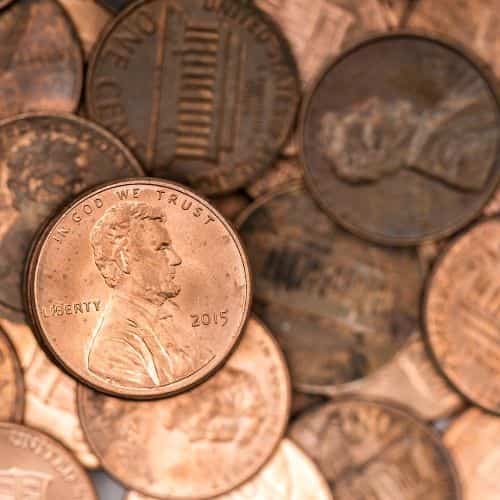
Are you a penny pincher who likes to save every copper coin?
Despite their minimal value, you’ll notice that once you start tucking pennies away for safe keeping, they add up quickly. But what if you’re saving up for a specific goal, like $100? How many pennies will you need to reach it, and even more importantly, how much will it all weigh?
With an individual value of $0.01, it would take 10,000 pennies to equal the comprised value of $100. In terms of weight, 100 pennies weigh an estimated 0.55 pounds (250 grams), and so, the 10,000 pennies required to reached $100 would weigh approximately 55.11 pounds (25 kilograms).
In this article, we’ll delve deeper into converting that mass of pennies into their appropriate dollar signs, so you know when you’ve reached your $100 goal. As you read, you’ll also learn about the average penny’s weight, what affects this weight, and how you can safely organize and store 10,000 pennies.
Recommended Financial Geek Article: What is American Money Made Of | A Complete Guide
How Many Pennies Are In $100 and What Does That Look Like?

While it might be impressive to jingle jars full of pennies, as the currency with the lowest value, you might be crestfallen to learn that in these massive, penny-filled jars is only a few dollars’ worth of money. Although this by no means should discourage you from saving your pennies, its reasonable that people want to know how many they need reach a reasonable savings goal of $100.
Pennies are each worth 1 cent (no, we’re not including collectibles of higher value). As there are 100 pennies in a dollar (0.01×100=1), there are 10,000 pennies in $100 (0.01×10,000=100).
At first glance, that figure of 10,000 might seem incredibly daunting, especially when you’re saving one penny at a time. Thankfully, 10,000 pennies, visually, isn’t as overwhelming as you might think.
Pennies have a diameter of 0.750 inches (19.05 mm) and a thickness of 1.52 mm, rendering them one of the smallest and thinnest US coins in use today. Therefore, by these measurements, if you were to place 10,000 pennies into a 5-gallon jug, there would only be enough to fill it halfway. Not so bad, right?
How Much Does 10,000 Pennies Weigh?
At some point or other, people saving their pennies and other coins do so with the intent of turning them in at a bank or coin-cashing machine so that can walk away with crisp dollar bills. After all, paying with paper money is far easier than counting out pennies. The only question is, how much weight are you carrying when you have $100 worth of pennies to turn in?
Pennies weigh 2.5 grams each, amassing a combined weight of 55.11 pounds of 25 kilograms for 10,000 pennies.
However, it is important to note that this is the weight of clean, modern-day penny made of copper plated zinc. Pennies can vary in weight depending on the year they were minted and their condition, so this weight of 55.11 pounds is an educated estimation.
Affect of Condition on Penny Weight
Condition is probably the only factor of a penny’s weight you can control. While you can’t fix a damaged penny that weighs less due chips and knicks, you can lighten the load by giving them a thorough cleaning. You’ll be surprised by how much weight that layer of dirt and grime can add when it’s coating nearly every penny you’ve saved.
Affect of Mint Year on Penny Weight
The other factor at play here is mint year. Prior to 1982, pennies were actually made of 95% copper and 5% tin rather than copper-plated zinc. As a result, these older coins are significantly heavier, weighing at 3.11 grams for a total weight of 68.56 pounds for 10,000 pennies.
Evidently, a collection of pennies minted prior to 1982 is going to weigh much more than a collection of modern pennies.
4 Ways to Store $100 Worth of Pennies

There’s no doubt that 10,000 pennies is a substantial number of coins to just have scattered around your house. One could easily misplace a handful of pennies or two without some way to properly store and organize them, and let’s be honest, you likely don’t want to store your 10,000 pennies in a bank, so you need some other ideas!
Luckily, we have a few suggestions for this.
The four best ways to store $100 worth of pennies include:
- Coin trays and a large capacity coin storage box
- A safe
- Piggy banks
- A 2.5-gallon container or jar
Determining which option is best for you will ultimately depend on your organization preferences and budget.
1. Coin Tray and Storage Box
Probably the most organized option is the first: coin trays and a large capacity coin storage box. If you’ve ever stepped foot into a bank, you’ve seen the tellers place rolls of coins on these indented coin trays.
These trays can fit 10 rolls of pennies (each roll valuing 50 cents) along with loose pennies until you have enough for a roll. You can even stack rolls if you want to limit how many trays you purchase.
For extra security and organization, we recommend purchasing a large capacity coin storage box where you can keep your trays of pennies and even padlock the box. While this isn’t as secure as a safe, it is a highly affordable option that will keep prying eyes from your savings.
2. A Safe
Investing in a safe might be a bit overboard considering you’ll likely spend more on the safe than the $100 you saved in pennies.
However, if you’re looking for maximum security for these coins, along with other valuable objects (maybe you found a rare penny worth substantially more than the others) then a safe might be worthwhile. In time, you might even find the money you’ve saved in coins has paid off the safe, and then some.
3. Piggy Banks
Ah, a classic choice. Piggy banks are a quick and easy way to store coins when you can’t be bothered to roll them up and don’t really care about keeping your pennies under lock and key.
Thankfully, these coin storage containers come in a range of designs and can be used as home décor just as easily as a savings station.
You’ll likely need more than one, but this gives you an opportunity to find fun ways to scatter them around the house. Maybe you could use two as book ends or place them in spaces where you’re likely to find or unload your pennies, like a foyer table or on a shelf above your washer/dryer machines.
4. A 2.5-Gallon Container or Jar

The most budget-friendly option on this list, by far, is to simply find a 2.5-gallon container or jar to store all your pennies in one place.
As we stated earlier, 2.5 gallons is approximately the amount of space it would take 10,000 pennies to fill, so this might be a great option for people who like a visual reminder of their progress. Once the jar is halfway full, you’ll know you’re halfway there!
Final Thoughts
Saving up 10,000 pennies for $100 is no small feat by any means, nor is lugging that 55 to 68-pound collection to the bank, but the satisfaction of achieving this accomplishment will make the effort more than worthwhile. Remember to use some of the storage options above to help you stay organized and motivated from penny #1 to 10,000!
Geek, out.


![Is It Illegal to Burn Money in the US? [Here are the Facts]](https://thefinancialgeek.com/wp-content/uploads/2022/09/is-it-illegal-to-burn-money.jpg)
![Chief Investment Officer vs Chief Financial Officer [COMPARED]](https://thefinancialgeek.com/wp-content/uploads/2022/09/CFO-vs-CIO-3.jpg)


![Here is Why Everything on Ali Express Is So Cheap [The Truth]](https://thefinancialgeek.com/wp-content/uploads/2022/05/why-is-everything-on-aliexpress-so-cheap-4.jpg)